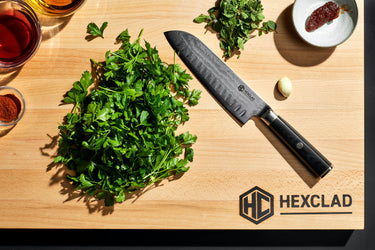5 Next-Level Knife Skills To Make You A Better Cook in 2024

So, you’ve mastered chopping and dicing and slicing. Give yourself a pat on the back. Wielding a knife with confidence is no small accomplishment! Now that you’re making quick work of a pile of onions, Julia Child-style, it’s time to level up. But, why should you know about knife cuts that go beyond the basics? Investing some time in learning new knife skills isn’t just about flair, they allow you to cook food uniformly so everything cooks at the same rate. (Read: no mushy carrots lurking alongside the perfectly tender ones.)
Popular in classic French cooking and professional kitchens worldwide, these techniques can bring sophistication to any dish. However, achieving perfectly consistent shapes can lead to a lot of waste. Save the scraps to make stock, or cook them in a vegetable stew (blend it if you don’t like the look of the wonky shapes).
Before you get started: With all knife work, safety is paramount. You’ll want to make sure your knives are sharpened and honed, and that you’ve got a sturdy cutting board that won’t slip or slide when working. And, of course, you’ll want to have the right knives on hand. A chef’s knife is key, as is a paring knife. For more on exactly what knife to pick for what task, check out our guide to using HexClad knives.
These 5 knife skills go beyond chopping and dicing
Batonnet

The fancy name for a vegetable stick, a batonnet will likely be familiar as the shape carrots, celery, and the like are cut into for dipping. It’s great for making even French fries, too. Start by cutting your vegetable into a 2-inch- to 3-inch-long piece. Slice one edge to create a flat surface, then repeat with each side until you have an even rectangle. Cut into ¼-inch thick planks, then cut those planks into ¼-inch “batonnets.” If you’ve got the hang of this method, you can work faster by stacking several of the planks and slicing them at once. Practice your batonnet cut with potatoes, which are easy to slice (and inexpensive). Then, fry them in your HexClad 7-Quart Hybrid Deep Sauté Pan and serve alongside steak for classic steak frites.
P.S. You can turn batonnets into an even dice by slicing them ¼-inch thick (which, if you want to get really French about it, is called a macédoine). Those perfectly square cubes will look wonderful in a hearty winter minestrone.
Brunoise
If you’re lusting after a plateful of perfect, tiny little cubes, then the brunoise—aka a fine dice—is for you. Made by slicing julienned vegetables into little cubes, a brunoise cut takes effort, but can be worth the payoff. To make a brunoise, start by cutting your ingredient into a julienne. Then, cut those sticks into ⅛-inch pieces, resulting in ⅛-inch cubes. You’ll want to use this cut for hardy vegetables like carrots, celery, turnips, and potatoes. It works well for onions, leeks, and fennel, too, though their curved shape will change the approach slightly. Separate the layers and proceed accordingly.
Julienne

These long, thin strips take a bit of effort to master, but your effort will pay off. About as thin as a toothpick, a julienne is made by cutting a 3-inch piece from a vegetable. After squaring the edges so they’re even, you’ll cut ⅛-inch thick slices, and then cut those slices into ⅛-inch pieces. You’ll probably see why the julienne cut is also referred to as the matchstick cut (or allumette, in French). Try this cut with carrots, which look gorgeous piled on a steaming bowl of pho or mixed into a simple green salad.
Mince
The finest level of chopping, a mince takes effort. Perfect for when you want an ingredient to melt into a dish—like onion or garlic—a mince is ideally around 1/16th of an inch. To get there, you’ll want to follow the same process of making julienne sticks, but rather than slicing them into ⅛-inch-thick planks, slice them 1/16-inch-thick slices. Then, slice these into 1/16-inch-thick sticks, and finally, into 1/16-inch-thick cubes. This is for the intrepid cook. Make sure your knife is extra sharp before starting.
Of course, there’s no need to be 100-percent precise when mincing. You can approach it more as an end goal, looking to cut the ingredients down into the smallest possible size. The goal is that the ingredient—whether a jalapeño or shallot—can be evenly distributed in the final dish, so if you don’t care about perfection, focus on getting as close as possible.
Chiffonade

Not just fun to say, a chiffonade cut produces beautiful ribbons that make your dish prettier. Used for herbs and leafy greens, you’ll make a chiffonade cut by stacking leaves end-to-end, then rolling them into a tight, cigar-shaped bundle. Then, slice thinly to produce fine, ribbon-like pieces. For herbs, the goal is to make fine, ⅛-inch slices, while with leafy greens like collard greens or kale, ¼-inch is best.





